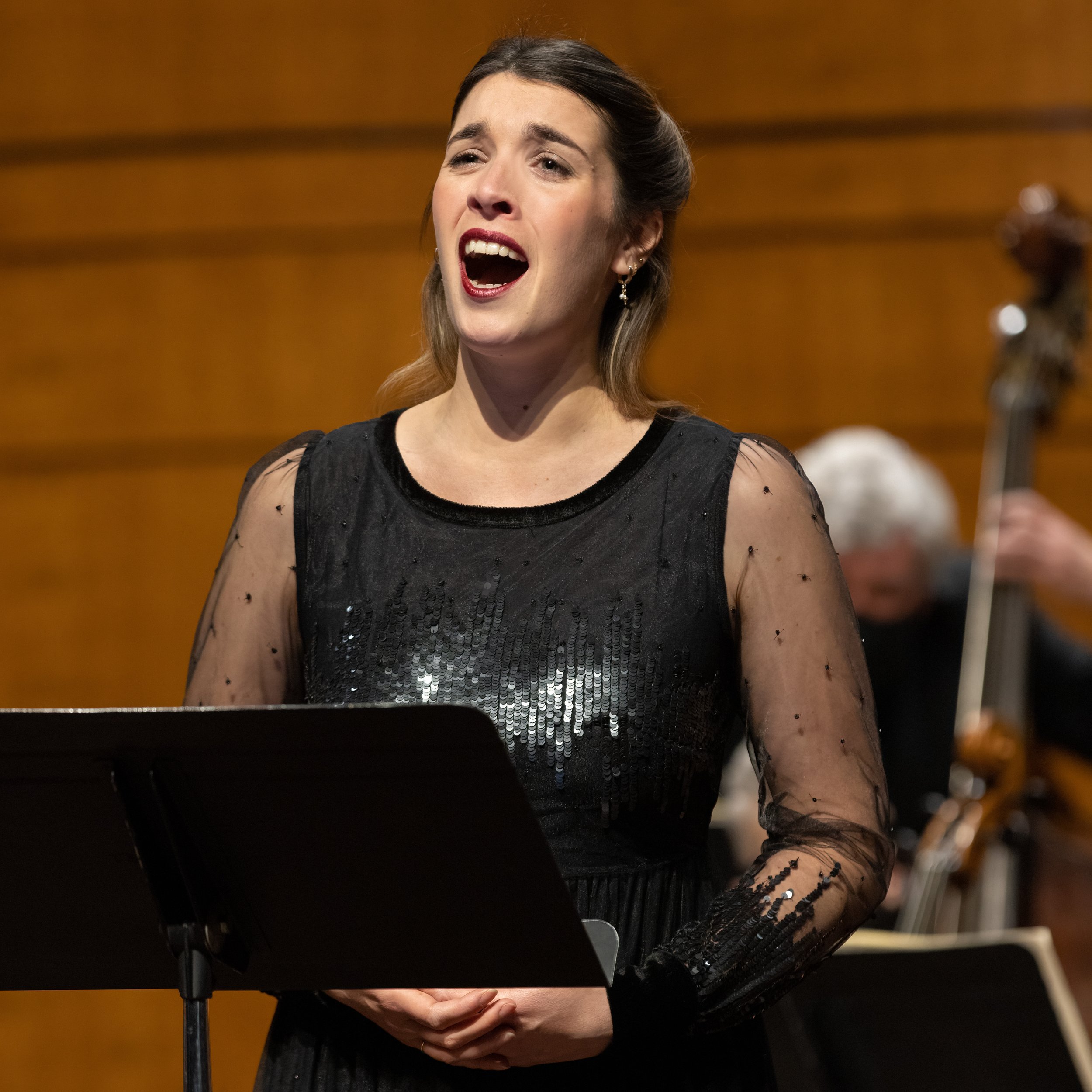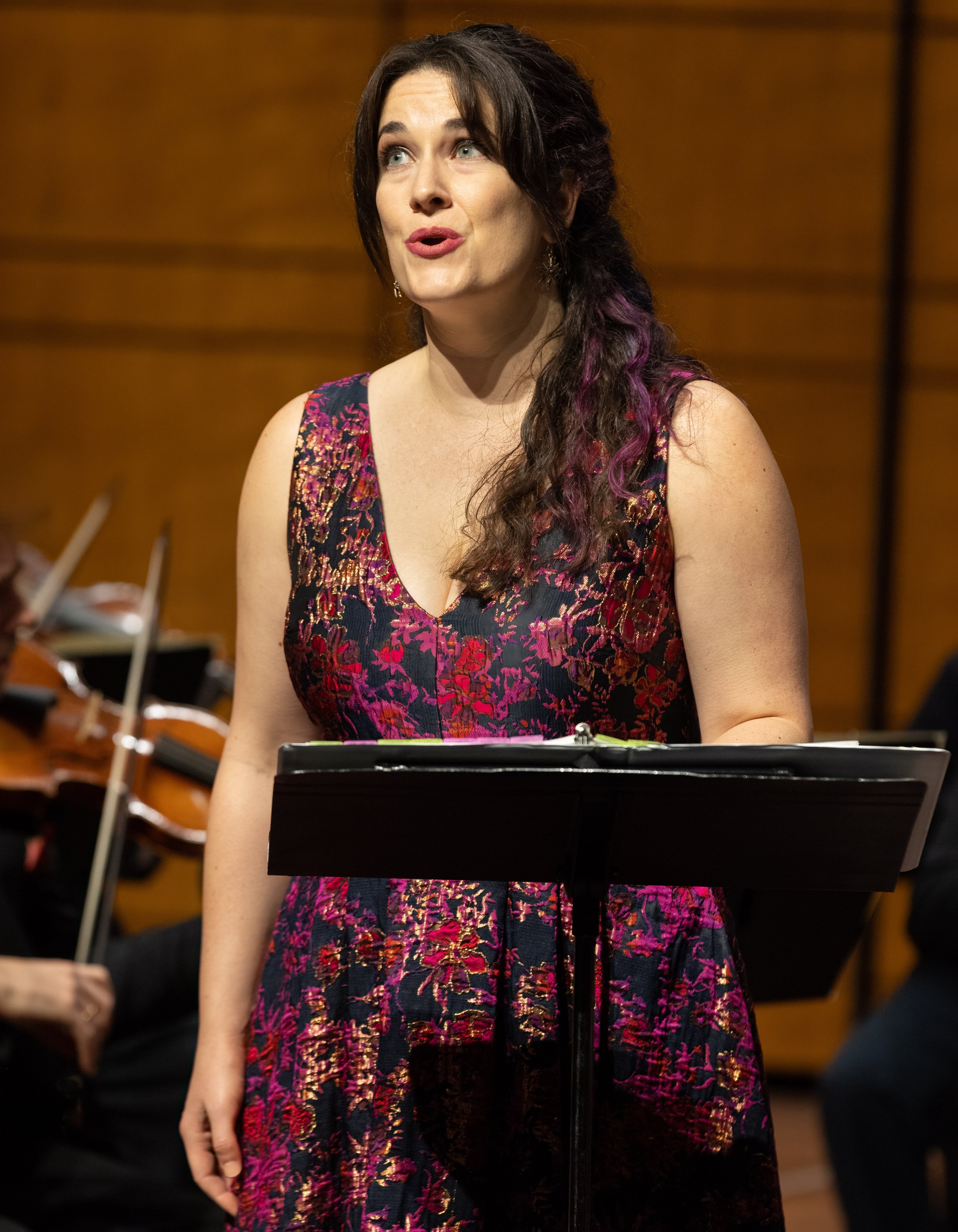Opera Lafayette constructed a three-part series for its 2022-2023 season titled “The Era of Madame de Pompadour”, covering the time when she was official chief mistress, confidante, and adviser to Louis XV; Madame de Pompadour was well known for her salons and theater that held sway on the music of that period. Each episode in the series features important music composed and played at that time in France; the company also offers its audiences opportunities to learn about social and political issues of those periods which influenced and were influenced by the music to be performed. Perhaps it appears surprising that this middle episode was devoted to music by the Italian composer, Giovanni Battista Pergolesi (1710-1736), who likely never entered France and whose most influential music likely did not until long after his death. The two works OL presented in the Kennedy Center’s Terrace Theater on Thursday evening, La Servante maîtresse (The Servant Mistress), a French version of Pergolesi’s intermezzo comedic opera, and Stabat Mater, a sacred vocal work in Latin, could hardly be more different. Nonetheless, both were the subject of controversies; and each became among the most popular works in France in the second half of the 18th century, remaining in the repertoire to the present day.
La Servante maîtresse (1754) is the French version by Pierre Baurans of Pergolesi’s La serva padrona (1733; librettist Gennaro Federico) and was the version that came to be preferred in France, mais oui. However, it was La serva padrona, first presented in Paris in 1752 by an Italian traveling group of comedic singers (bouffons) that initiated its popularity and led to a furious, two-year debate in Paris called the “querelle des bouffons” over whether this new Italian form of comic opera was superior to French opera. Some big wig French intelligentsia of the day, such as Jean-Jacques Rousseau (“Man is borne free but everywhere is in chains”) championed the new opera, perhaps with an underlying motive of wanting to encourage social change in France. The debate died away, but Italian comic opera had arrived and swept across Europe.
Jonathan Woody as Pandolfe and Hannah De Priest as Serpine. Photo by Jennifer Packard Photography; courtesy of Opera Lafayette.
La serva padrona had to be altered when first performed in Paris because opera performed outside the Paris Opéra at that time had to include dialog; so, the recitative with continuo had to be replaced with spoken dialog, also continued in the French version. The French adaptation also injected a few new arias giving the female lead a softer edge, but the story and music were largely kept intact. This forty-minute opera with two singers, was originally performed as entertainment between the acts of larger serious operas. In the story, a male head of the household, Pandolfe (Uberto in the La serva padrona), is upset with his maid who consistently fails to do his bidding. The maid, Serbine (Serpina), wants to become his wife and mistress of the house. She is aided in a bit of successful trickery by a mute manservant, Scapin (Vespone). Overall, La Servante maîtresse provides a French-Italian pastry: some funny scenes, delightful singing and music, a happy ending…and proof that the women of 18th century France wielded more power than had been formally authorized.
Listening to OL’s performance, my first impression of this opera was that the rapid delivery of text in the singing, often of a patter nature, and the relatively large amount of spoken dialog was pushing the music into the background; it took me a moment to adjust, and perhaps the singers as well, who had to sing in French and recite dialog in English. Director Nick Olcott wrote rhyming couplets for the spoken dialog to assist the largely English-speaking audience in quickly spotting and reacting to the humor; it worked but did require some getting used to, which then allowed me to enjoy the tuneful music more fully. The performance was semi-staged with the orchestra on stage behind the singers. Mr. Olcott effectively used chairs to help control the movements and give focus to the interactions. The costumes by Marsha LeBoeuf were colorful and period appropriate, adding to the fun.
Patrick Kilbride as Scapin. Photo by Jennifer Packard Photography; courtesy of Opera Lafayette.
The comedy was greatly enhanced by the antics of tenor Partrick Kilbride, portraying the mute attendant Scapin who pretended to be a suitor for Serpina, in accord with her plan; this was Mr. Kilbride’s first appearance with Opera Lafayette in which he did not sing. Another OL veteran, bass-baritone Jonathan Woody sang the role of Pandolfe, convincingly expressing emotions ranging from exasperation with Serpina to accepting his deep-felt affection for her. He sang well and soon found a natural rhythm for the spoken rhyming couplets. This is Serpina’s opera and OL had engaged a soprano to match her. Hannah De Priest with her beautiful voice, singing, and acting ability won over the audience long before she did Pandolfe; she gave us a young woman who not only survived but prevailed by her wits. Her performance was a highlight of the evening! Opera Lafayette managed to handle the edgier aspects of the social order on display in the opera without dampening enthusiasm for the comedy.
Jonathan Woody as Pandolfe, Hannah De Priest as Serbine, and Patrick Kilbride as Scapin. Photo by Jennifer Packard Photography; courtesy of Opera Lafayette.
La serva padrona introduced a new musical style to France, one more direct and simpler compared to the intricate and complex music of the most popular French operas of the day, and the opera’s style influenced many of the French composers who rose to prominence in the second half of the 18th century. The Opera Lafayette Orchestra for the evening was led by Guest Conductor Patrick Dupré Quigley. The orchestra uses period instruments, providing an authentic production of 18th century music. In an OL online discussion, Conductor Quigley pointed out that the two works presented were very different in both musical style and vocal delivery. I thought the orchestra’s delivery on both under Maestro Quigley’s leadership was engaging and enjoyable throughout the evening, fully supporting the singing.
l to r: Sarah Mesko, Gwendoline Blondeel, and Conductor Patrick Dupré Quigley performing Pergolesi’s Stabat Mater. Photo by Jennifer Packard Photography; courtesy of Opera Lafayette.
The 13th century poem “Stabat mater dolorosa” (“mother standing in sadness”, author uncertain) described Mother Mary’s anguish on Calvary and served as the text for Pergolesi’s Stabat Mater, as it did for a great many composers. In fact, if you wanted and were able to find recordings, you could listen to Stabat Mater by a different composer everyday from January 1 until September before you would have to play a repeat. This would include versions by Rossini, Schubert, Dvořák, Vivaldi, Verdi, Poulenc, and quite a few other well-known composers. However, if you type Stabat Mater into the search engine of almost any music service, the first version shown will be that by Giovanni Battista Pergolesi (not even his family’s given name, which was Draghi; his family came to be known for the town they were from, Pergola).
l to r: Sarah Mesko and Gwendoline Blondeel. Photo by Jennifer Packard Photography; courtesy of Opera Lafayette.
Stabat Mater initially focuses on the grief of a mother, who stood while forced to watch her son being crucified; the second half of the poem moves to a spectator’s viewpoint, that of someone wanting to share in Mary’s grief as a path to salvation. This sacred work was composed shortly before Pergolesi’s death from tuberculosis at the age of 26 and was written in a monastery where he died in poverty. Some have suggested it was Pergolesi’s gift to God in his final days; let me suggest that it might also have been God’s gift to Pergolesi and all of us. From that young man came one of the most beautiful pieces of music ever, written near the end of a composing career of only five years. One difficulty I have listening to this work is how much pleasure it gives me, given its subject matter. Perhaps because I fell in love with this piece long before I read an English translation of the poem, I find the music beautiful and reverential, not beautiful and sad. The Catholic Church had difficulty with this as well, which later led to a papal decree that opera music using religious texts could not be performed in church. Art won that one and churches all over the Catholic world have staged it; in 2017 a new Stabat Mater by composer Sir James MacMillan was premiered at and later streamed from the Vatican.
Gwendoline Blondeel and Sarah Mesko. Photos by Jennifer Packard Photography; courtesy of Opera Lafayette.
Stabat Mater is scored for a soprano and an alto, originally male singers since women were not allowed to sing in the Catholic Church. For their performance, Opera Lafayette employed two extraordinary singers with extraordinary voices, French soprano Gwendoline Blondeel, in her first appearance in the U.S, and mezzo-soprano Sarah Mesko in her OL debut. Ms. Blondeel has a bright, crystalline soprano voice, while Ms. Mesko’s mezzo-soprano voice sounded much deeper, darker. Within minutes, the beauty of their voices and their harmony creating its own beautiful sound caused my eyes to well up with tears. The piece has four movements and many opportunities for solos and duets. Ms. Blondeel approached the piece as church music, her face reverent but expressionless. Ms. Mesko treated it more as opera; her final solo was a dramatic rendition, both acting with facial expressions and singing the part. The OL orchestra under Mr. Quigley’s direction brought Pergolesi’s music fully to life tightly intertwined with the vocals. The performance overall was simply exquisite.
Photo of Stabat Mater performance rehearsal; the ensemble for La Servante maîtresse also included two horn players and a bassoonist. Photo by Jennifer Packard Photography; courtesy of Opera Lafayette.
We all have memories that stay with us. I recall watching the first moon landing on television and the first time that I saw the Sound of Music. I have no doubt that Opera Lafayette’s Pergolesi! is burned into my memory. It was a performance to remember.
The Fan Experience: The performance of Pergolesi! at the Kennedy Center was the first of two that OL will give; there is still time to get tickets for the second one (see below); program notes by OL musicologist Julia Doe, are available online. Subtitles in English were shown on a screen above the orchestra for both works, a major advantage for hearing Stabat Mater for the first time. An informative and entertaining pre-concert talk was given by Cornell Emeritus Professor Rebecca Harris-Warrick, an expert on French baroque music and a guest scholar with OL.
All of Opera Lafayette’s productions for 2022-2023 were scheduled to be performed in both Washington, DC (Terrace Theater of the Kennedy Center) and New York City (El Museo del Barrio). In DC, they will be spread over the entire season and in NYC performed as a festival.
Washington, DC:
In the Salons of Versailles – December 2
Pergolesi! - February 2
Opéra-ballet - Rameau’s Io and de La Garde’s Léandre et Héro - May 2, 3
New York City:
Opéra-ballet: Rameau’s Io and de La Garde’s Léandre et Héro - May 9
In the Salons of Versailles - May 10
Pergolesi! - May 11








